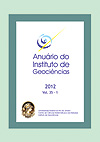Santa Cruz Fortress: historical and Geological Heritage of Niterói, RJ, Brazil
DOI:
https://doi.org/10.11137/2012_1_222_235Abstract
First fortress erected at the entrance of Guanabara Bay, National Historical Landmark since 1939 and occupying an area of over seven thousand square meters, the Fortress of Santa Cruz stands out among the numerous historical works in which augen gneiss was used as raw material. Its construction, which comprises three main architectural periods, related to the early 17th century and the 18th and 19th centuries, has this rock as the main material as stonework in the form slabs, blocks and arches. The promontory under the fortress rock outcrop has a slab form resulting of a subhorizontal foliation. It´s still consisted of augen gneiss but despite the clear correlation between the rock outcrop and those exposed in the stonework's, it was common in the 1990s to assign a European origin to the rocks used in its construction. This mystical, release between tourists and at local news media at that time, still persists in the popular account, resulting in loss of historical identity. Thus, the Fortress of Santa Cruz, with its overlapping masonry for over three centuries and whose natural features can be observed at in situ outcrop, should be considered not only historical, but also a geological heritage, that allows visitors to understand the importance of the mining industry in Niteroi's development. This paper present an overview of the augen gneiss outcropping and of the rocks exposed as stonework in the Santa Cruz Fortress.Downloads
Download data is not yet available.
Downloads
Published
2012-06-01
How to Cite
Almeida, S. and Almeida, C. M. de (2012) “Santa Cruz Fortress: historical and Geological Heritage of Niterói, RJ, Brazil”, Anuário do Instituto de Geociências. Rio de Janeiro, BR, 35(1), pp. 222–235. doi: 10.11137/2012_1_222_235.
Issue
Section
não definida
License
This journal is licensed under a Creative Commons — Attribution 4.0 International — CC BY 4.0, which permits use, distribution and reproduction in any medium, provided the original work is properly cited.















